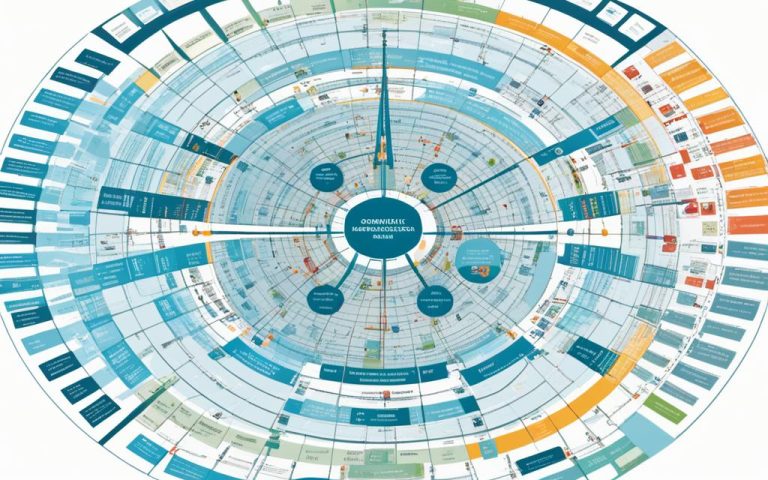Efficient data transmission and seamless connectivity are paramount in Low Earth Orbit (LEO) satellite networks. These networks rely on specialized communication protocols to enable interoperability, reduce costs, and provide direct access to satellite data. However, implementing IP-based solutions for LEO satellites comes with its own set of challenges.
Wireless communications in space have different characteristics than wired communications on Earth. To address this, NASA has conducted extensive research on IP-based missions in LEO and has identified the feasibility and benefits of using IP protocols. However, unresolved issues need to be addressed before implementation.
In this article, we will explore the challenges of implementing IP-based solutions for LEO satellite networks, the design considerations for an end-to-end IP-based mission, the standardization efforts in LEO satellite networking, the research challenges and future directions in LEO satellite networking, and the deployment of Mobile Edge Computing (MEC) servers on LEO satellites. Through these discussions, we aim to highlight the importance of communication protocols in efficient LEO satellite networks and the ongoing efforts to enhance connectivity in space.
Challenges of IP-based Solutions for LEO Satellite Networks
Implementing IP-based solutions for LEO satellite networks presents various challenges. The unique wireless environment in space, characterized by higher bit error rates, increased latency, and limited bandwidth, poses obstacles to the performance and efficiency of IP protocols designed for terrestrial computing.
The current practice of encapsulating CCSDS (Consultative Committee for Space Data Systems) data into IP-based packets for transmission over the internet necessitates additional processing, potentially leading to issues related to fragmentation and routing. These challenges must be addressed to ensure seamless and reliable communication within LEO satellite networks.
To overcome these obstacles, extensive research and development efforts are required. Enhancing the robustness of IP protocols in wireless networks and tailoring them to meet the specific requirements of LEO satellite communications are crucial steps towards achieving optimal performance and efficiency.
Key Challenges of IP-based Solutions for LEO Satellite Networks:
- Higher bit error rates
- Increased latency
- Limited bandwidth
- Potential fragmentation and routing issues
Research and Development Solutions:
Resolving these challenges necessitates focused research and development efforts, including:
- Enhancing the robustness of IP protocols to mitigate the impact of higher bit error rates
- Developing strategies to minimize latency and optimize the use of limited bandwidth
- Addressing issues surrounding fragmentation and routing to ensure seamless data transmission
- Exploring innovative approaches to optimize IP protocols for LEO satellite networks
By addressing these challenges head-on, the satellite industry can pave the way for efficient and reliable IP-based solutions in LEO satellite networks, enabling seamless connectivity and unlocking the full potential of space-based communication.
| Challenge | Solution |
|---|---|
| Higher bit error rates | Enhancing the robustness of IP protocols to mitigate errors and ensure reliable data transmission. |
| Increased latency | Developing strategies to minimize latency and optimize real-time communication. |
| Limited bandwidth | Optimizing the use of limited bandwidth through innovative compression and data transmission techniques. |
| Fragmentation and routing issues | Addressing fragmentation and routing challenges to ensure seamless and efficient data transmission. |
Designing an End-to-End IP-based Mission for LEO Satellites
An end-to-end IP-based mission for LEO satellites is a strategic initiative aimed at establishing direct communication between LEO satellites and ground infrastructure. This mission enables seamless integration with terrestrial computing, leveraging the power of IP-based solutions. By employing IP protocols across various functions such as science instruments, health and welfare monitoring, and ground station communication, efficient data transmission and streamlined operations can be achieved.
One of the key advantages of an IP-based approach is the ability to collect and transmit data in IP packets, eliminating the need for extensive data transformation and wrapping processes. This not only simplifies the workflow but also reduces the number of facilities required, making the mission more cost-effective.
Furthermore, IP protocols have become pervasive in the computing community, making them an ideal choice for LEO satellite missions. Their widespread usage ensures compatibility with existing systems and provides a solid foundation for scalability and future advancements.
However, the wireless characteristics of LEO satellite networks must be carefully considered during the design phase. Factors such as higher bit error rates, increased latency, and limited bandwidth pose unique challenges that need to be addressed to ensure the efficient functioning of IP protocols.
“An end-to-end IP-based mission for LEO satellites enables seamless integration between space and terrestrial computing, revolutionizing the way data is collected and transmitted.”
To provide a holistic understanding of the end-to-end IP-based mission, the following table outlines the key components and their respective functions:
| Component | Function |
|---|---|
| Science Instruments | Gather data from space for scientific analysis |
| Health and Welfare Monitoring | Monitor satellite health and ensure optimal performance |
| Ground Station Communication | Exchange data between the satellite and ground infrastructure |
By integrating these components into a cohesive IP-based framework, the end-to-end mission maximizes efficiency, reduces complexity, and opens up new possibilities for scientific research and data-driven decision-making.
With ongoing advancements in both IP-based solutions and LEO satellite technologies, the design and implementation of an end-to-end IP-based mission hold considerable promise for future space exploration and scientific endeavors.
Stay tuned for the next section, where we will explore the standardization efforts for LEO satellite networking.
Standardization Efforts for LEO Satellite Networking
Standardization efforts are crucial for the development and implementation of efficient LEO satellite networking. These initiatives aim to establish protocols and guidelines that enable seamless communication and interoperability within LEO constellations. Two prominent organizations involved in this standardization process are the 3rd Generation Partnership Project (3GPP) and the Internet Engineering Task Force (IETF).
3GPP:
The 3rd Generation Partnership Project (3GPP) is actively engaged in defining standards for LEO satellite networking. With a focus on inter-satellite links and communication, 3GPP is working towards enabling compatibility between satellites from different vendors. This collaboration facilitates the integration of diverse satellite systems and promotes efficient data transmission.
IETF:
The Internet Engineering Task Force (IETF) is also dedicated to the standardization efforts within LEO satellite networking. By developing protocols that address the unique challenges of satellite networks, such as dynamic topology, data traffic imbalance, and efficient routing, IETF aims to enhance the performance and scalability of LEO constellations.
Through their collective efforts, these standardization bodies contribute to the overall integration and evolution of LEO satellite networking.
Key Standardization Objectives:
- Enabling communication between satellites from different vendors
- Promoting interoperability within LEO constellations
- Addressing challenges specific to satellite networks
- Facilitating efficient routing and data transmission
By establishing common protocols and guidelines, the satellite networking industry can achieve greater integration and scalability. The standardized framework allows for seamless connectivity and ensures that LEO satellite networks operate seamlessly, paving the way for enhanced communication capabilities in space.
Standardization Efforts in LEO Satellite Networking
| Organization | Focus | Goals |
|---|---|---|
| 3rd Generation Partnership Project (3GPP) | Inter-satellite links and communication | Compatibility between satellites from different vendors |
| Internet Engineering Task Force (IETF) | Protocols for satellite networks | Enhanced performance and scalability of LEO constellations |

Standardization efforts play a vital role in establishing a robust framework for LEO satellite networking. As the satellite industry continues to grow and evolve, these initiatives ensure that LEO networks adhere to common guidelines, enabling efficient and seamless communication among satellites.
Research Challenges and Future Directions in LEO Satellite Networking
The field of LEO satellite networking is an ever-evolving domain that presents both research challenges and exciting opportunities for the future. Researchers are exploring emerging technologies and domains such as Machine Learning, Software-Defined Networking (SDN), low latency networking, green networking, and Information-Centric Networks to enhance the performance and efficiency of LEO satellite networks.
Improving Routing Strategies
One of the key research areas in LEO satellite networking is the improvement of routing strategies. With the increased complexity and scale of LEO constellations, designing efficient and robust routing protocols is crucial to ensure seamless communication and data transmission. Researchers are exploring innovative approaches to optimize routing algorithms, minimize packet loss, and improve network performance.
Space-Qualified Communication Hardware and Software
Another research challenge in LEO satellite networking is the development of space-qualified communication hardware and software. LEO satellites operate in harsh and extreme environments, requiring specialized communication equipment that can withstand radiation, temperature fluctuations, and vibration. Researchers are focusing on designing and testing communication systems that are resilient and reliable in these challenging conditions.
Scalability and Interoperability of LEO Constellations
As LEO constellations continue to grow in size and complexity, ensuring scalability and interoperability becomes a critical research area. Researchers are exploring methods to optimize constellation design, manage constellation dynamics, and enable seamless communication between satellites from different vendors. The goal is to establish a unified and interoperable LEO satellite network that can efficiently exchange data and provide global coverage.
Integration with 5G and Beyond
Future research directions in LEO satellite networking include the integration of LEO satellites with 5G networks and beyond. The combination of LEO satellite networks with terrestrial 5G infrastructure holds great potential for expanding connectivity, enhancing data rates, and enabling new services and applications. Researchers are exploring the technical challenges and opportunities in integrating LEO satellites with 5G networks to create a seamless and ubiquitous communication ecosystem.
Protocols for Upcoming Constellations
In anticipation of upcoming constellations with thousands of satellites, researchers are actively working on designing communication protocols that can handle the scale and complexity of these networks. These protocols should address challenges such as efficient resource allocation, congestion control, and network management. By developing robust and scalable protocols, the future constellations can optimize network performance and provide reliable connectivity on a global scale.
Exploring 6G Networks
Looking ahead, researchers are also exploring the potential of 6G networks in the context of LEO satellite networking. 6G networks are expected to deliver ultra-high data rates, near-instantaneous communication, and support for emerging technologies such as holographic communication and immersive virtual reality. The integration of LEO satellite networks with 6G has the potential to revolutionize the way we communicate, collaborate, and access information from space.
As LEO satellite networking continues to advance, researchers are committed to addressing the research challenges and driving the future directions of this exciting field. Through innovative solutions, collaboration, and integration of cutting-edge technologies, the vision of a seamless and interconnected LEO satellite network is becoming closer to reality.
Deployment of Mobile Edge Computing (MEC) Servers on LEO Satellites
The deployment of Mobile Edge Computing (MEC) servers on LEO satellites offers a promising solution to tackle delays and enhance computing capabilities at the network’s edge. MEC satellites leverage the unique advantages of LEO satellite networks, including near-real-time communication, wide coverage, and anti-destructive properties.
Efficient and secure data transmission in MEC satellites heavily relies on well-designed routing strategies. In recent research, significant focus has been placed on developing routing strategies that take into account uncertain link information. These strategies utilize membership degree functions to describe the uncertainty caused by complex space environments.
The primary objective of these innovative routing strategies is to improve overall performance when compared to traditional routing counterparts used in LEO satellite networks. By providing optimized routing paths and effectively managing uncertain link conditions, MEC satellites can deliver enhanced connectivity and seamless transmission of data.
| Advantages of MEC Servers on LEO Satellites |
|---|
| Reduced delays in data transmission |
| Enhanced computing capabilities at the network’s edge |
| Leveraging near-real-time communication of LEO satellite networks |
| Improved coverage and anti-destructive properties |
By deploying MEC servers on LEO satellites, organizations can harness the benefits of edge computing and satellite networks to deliver efficient and reliable communication services. These advancements have the potential to revolutionize various industries, such as remote sensing, disaster management, and IoT (Internet of Things) applications in remote locations.
Conclusion
LEO satellite protocols are integral for ensuring efficient communication in Low Earth Orbit networks. The implementation of IP-based solutions may pose challenges due to the unique characteristics of wireless communications in space. However, ongoing standardization efforts are paving the way for establishing protocols and guidelines that enable seamless LEO satellite networking.
Research studies are exploring new domains and technologies to address the evolving needs of LEO satellite networks, with a focus on improving performance and efficiency. The deployment of Mobile Edge Computing (MEC) servers on LEO satellites shows great promise in reducing delays and improving overall network performance.
Continued research and development in LEO satellite protocols are essential to meet the growing demands of the satellite industry and enable efficient and seamless connectivity in space. By overcoming the challenges and leveraging advancements in technology, LEO satellite networks can unlock their full potential and pave the way for a future where efficient communication in space is a reality.
FAQ
What are LEO satellite protocols?
LEO satellite protocols are communication protocols designed specifically for Low Earth Orbit (LEO) satellite networks. These protocols enable efficient data transmission and seamless connectivity in LEO satellite networks.
What are the challenges of IP-based solutions for LEO satellite networks?
Implementing IP-based solutions for LEO satellite networks comes with challenges such as higher bit error rates, higher latency, and smaller bandwidth in the wireless environment of space. These factors can affect the performance and efficiency of IP protocols designed for terrestrial computing.
What is an end-to-end IP-based mission for LEO satellites?
An end-to-end IP-based mission for LEO satellites aims to establish direct communication between the satellites and the ground, enabling seamless integration with terrestrial computing. This design concept involves using IP protocols for science instruments, health and welfare monitoring, and communication between the satellite and ground stations.
What are the standardization efforts for LEO satellite networking?
Standardization bodies such as 3GPP (3rd Generation Partnership Project) and IETF (Internet Engineering Task Force) are involved in defining protocols and guidelines for LEO satellite networking. These efforts aim to enable interoperability between satellites from different vendors and ensure seamless communication within LEO constellations.
What are the research challenges and future directions in LEO satellite networking?
Research studies in LEO satellite networking are exploring emerging domains such as Machine Learning, SDN (Software-Defined Networking), and Information-Centric Networks to enhance performance and efficiency. Future directions include integrating LEO satellites with 5G networks, exploring the potential of 6G networks, and designing protocols for upcoming constellations with thousands of satellites.
What is the deployment of Mobile Edge Computing (MEC) servers on LEO satellites?
The deployment of Mobile Edge Computing (MEC) servers on LEO satellites involves placing computing capabilities at the edge of the network to reduce delays and improve overall performance. This utilizes the advantages of LEO satellite networks, such as near-real-time communication, wide coverage, and anti-destructive properties.
What is the conclusion regarding LEO satellite protocols?
Continued research and development in LEO satellite protocols are essential to meet the demands of the growing satellite industry and enable efficient communication in Low Earth Orbit (LEO) networks.



















